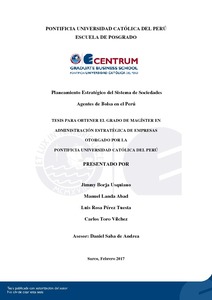| dc.contributor.advisor | Saba de Andrea, Daniel Antonio | |
| dc.contributor.author | Borja Usquiano, Jimmy | es_ES |
| dc.contributor.author | Landa Abad, Manuel | es_ES |
| dc.contributor.author | Rosa Pérez Tuesta, Luis | es_ES |
| dc.contributor.author | Toro Vílchez, Carlos | es_ES |
| dc.date.accessioned | 2017-03-20T16:40:08Z | |
| dc.date.available | 2017-03-20T16:40:08Z | |
| dc.date.created | 2017 | |
| dc.date.issued | 2017-03-20 | |
| dc.identifier.uri | http://hdl.handle.net/20.500.12404/8267 | |
| dc.description.abstract | El principal negocio de las Sociedades Agentes de Bolsa en el Perú es la
intermediación financiera directa entre los agentes superavitarios y deficitarios que participan
en los mercados de valores a nivel nacional, especialmente en la Bolsa de Valores de Lima
(BVL), donde tienen exclusividad de intermediación; también participan en otros mercados
extrabursátiles, como por ejemplo en el mercado de divisas.
El desempeño de las SABs ha estado estrechamente relacionado con la evolución de
la BVL, la cual obtuvo excelentes resultados la década pasada, hasta su caída durante la crisis
financiera internacional en 2009. Posteriormente presentó una recuperación, pero se deterioró
con mayor fuerza los últimos años, tanto en liquidez como en la profundidad de sus
operaciones. Esta situación se refleja en los índices bursátiles que de un incremento de 65%
en 2010, obtuvieron cifras negativas los siguientes años, llegando a bajar en 33.43% en 2015.
En este contexto, el presente estudio analiza los factores externos e internos que
afectan a las 26 SABs, proponiendo 8 estrategias, 4 objetivos de largo y 24 corto plazo que
permitirán lograr, al 2026, que el sistema de intermediación financiera conformado por las
SABs destaque como uno de los mejores entre sus pares latinoamericanos, y a su vez
contribuya al desarrollo del país.
Con este planeamiento estratégico, se busca alcanzar un futuro promisorio en el que
las SABs mejoren de manera sustancial la calidad y variedad de su oferta a partir del uso de
las tecnologías de información y la incorporación de personal altamente calificado a lo largo
de toda su cadena de valor hasta llegar al cliente; logrando convertirse en empresas altamente
rentables que conforman un clúster financiero en Lima, en cuyo marco colaboran
estrechamente con actores claves como bancos, administradoras de fondos de pensiones
(AFP), fondos mutuos, la BVL, la Superintendencia del Mercado de Valores (SMV), entre
otros con el fin de elevar el nivel de desarrollo e innovación en el sector | es_ES |
| dc.description.abstract | Stock Brokerage Firms’ (SAB in Spanish) predominant business in Peru is direct
financial intermediation between surplus and deficit agents that participate in different local
markets, mainly the Lima Stock Exchange (BVL in Spanish). Although, SABs are
intermediaries mostly at the BVL, they also compete with different intermediaries in other
over the counter (OTC) markets; such as the foreign exchange market.
SABs performance throughout the time has been closely related to the BVL, which
obtained excellent results the last decade until it was impacted by the global financial crisis in
2009. Even though the BVL has recovered somehow, this recovery has not been constant and
it has declined severely in the last years; both in liquidity and operations’ relevance. This
situation has been connected to the BVL stock index decrease, which improved a 65% in
2010 and then declining in the following years until it reached 33.43% in 2015.
Within this context, this study intends to analyze the external and internal factors
affecting the 26 SABs currently operating in our country. From this analysis, 8 strategies, 4
long-term and 24 short-term objectives are posed to allow our SABs to transcend, by 2016, as
one of the best intermediaries among their Latin-American peers; due to its high service
quality contributing to Peru’s stock exchange market.
When putting in practice this strategic planning, we can foresee a promising future for
SABs, as they will substantially improve the quality and variety on their offers from the use
of information technologies and incorporating highly qualified personnel throughout their
value chain until reaching the client. This way, the SABs will become highly profitable
companies forming a financial cluster in Lima, collaborating closely with key parties such as
banks, AFPs (Private Pension Fund in Spanish), mutual funds, the BVL, the SMV (Peruvian
Superintendency of Securities Market in Spanish), and others in order to heighten the market
development and innovation level | es_ES |
| dc.language.iso | spa | es_ES |
| dc.publisher | Pontificia Universidad Católica del Perú | es_ES |
| dc.rights | info:eu-repo/semantics/openAccess | es_ES |
| dc.rights.uri | http://creativecommons.org/licenses/by-nc-nd/2.5/pe/ | * |
| dc.subject | Bolsa de valores -- Perú | es_ES |
| dc.subject | Corredores de bolsa -- Perú | es_ES |
| dc.subject | Planificación estratégica | es_ES |
| dc.title | Planeamiento estratégico del sistema de sociedades agentes de bolsa en el Perú | es_ES |
| dc.type | info:eu-repo/semantics/masterThesis | es_ES |
| thesis.degree.name | Maestro en Administración Estratégica de Empresas | es_ES |
| thesis.degree.level | Maestría | es_ES |
| thesis.degree.grantor | Pontificia Universidad Católica del Perú. CENTRUM | es_ES |
| thesis.degree.discipline | Administración Estratégica de Empresas | es_ES |
| renati.discipline | 413307 | es_ES |
| renati.level | https://purl.org/pe-repo/renati/level#maestro | es_ES |
| renati.type | https://purl.org/pe-repo/renati/type#tesis | es_ES |
| dc.publisher.country | PE | es_ES |
| dc.subject.ocde | https://purl.org/pe-repo/ocde/ford#5.02.04 | es_ES |






